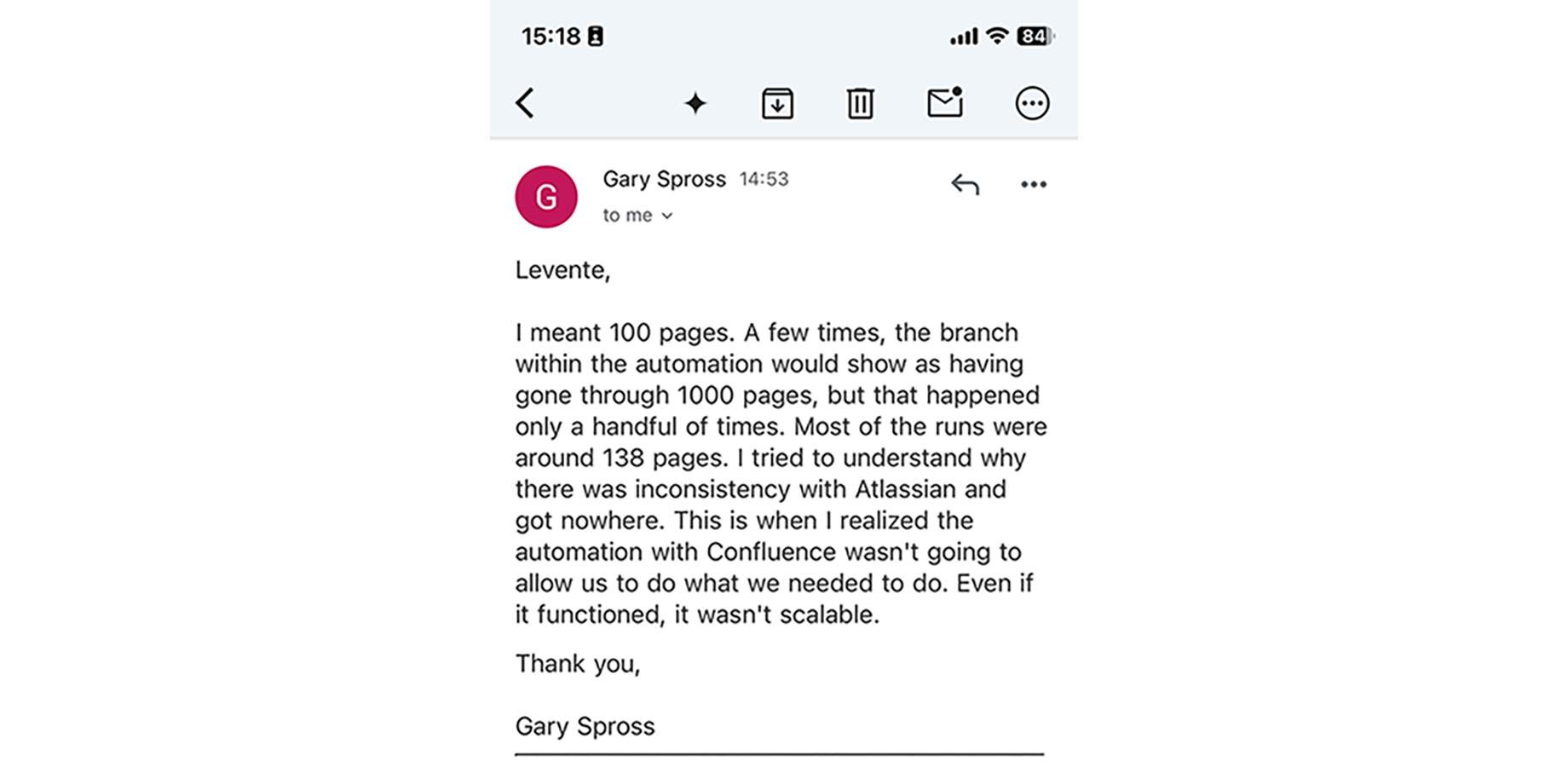"We attempted utilizing Confluence Automation. In the end, that effort was ultimately a waste of time."
— Gary starts his answer when asked about their journey of automating content lifecycle management for Confluence Cloud.
nCino, a leader in financial technology, relies on Confluence Cloud to manage vast amounts of internal documentation, with over 1,400 users collaborating daily.
When Gary Spross, Principal Atlassian Cloud Administrator at nCino, set out to establish a content lifecycle management (CLM) process for his company’s Confluence instance, he thought the built-in Automation for Confluence would be the answer.
But like many teams dealing with content growth, outdated documentation, and compliance requirements, nCino quickly realized that Automation for Confluence simply couldn’t scale to their needs. Rules failed, page limits were reached, and critical data wasn’t available.
After months of struggling to make Automation for Confluence fit, Gary and his team found a new approach that actually worked.
The problem: outdated content, compliance gaps, and inefficient search
Before finding a content lifecycle management (CLM) solution, nCino faced several significant challenges. Their Confluence instance was cluttered with outdated and irrelevant content, making it difficult for users to find accurate and trustworthy information.
The lack of a structured CLM process led to inefficiencies, degraded performance, and compliance issues. The team needed a robust solution to address these problems and streamline their content management.
Gary's team identified 4 main reasons for wanting to impose a Confluence content lifecycle management process:
- Relevancy — ensuring the content pertains to existing nCino products and relationships and is actively being utilized.
- Accuracy — ensuring the content is up to date and therefore trustworthy.
- Cleanliness — an organized instance is much easier for users to navigate and ensures the performance of our instance is not degraded.
- Compliance — our company policies dictate the removal of old, outdated, and inactive content."
The team needed a scalable solution to maintain order, ensure compliance, and improve the overall Confluence experience. They were led to believe that Automation for Confluence could be the answer, as Atlassian often pushes it for content lifecycle management use cases.
A failed detour: why Automation for Confluence didn’t work
Gary’s team tried to implement their own lifecycle management system using Automation for Confluence. Given the size of nCino’s Confluence instance, managing documentation was a daunting task, and the built-in mechanisms for content maintenance were either nonexistent or extremely limited.
"We built several automation rules that would label pages based on last view and last updated criteria, notify users, and ultimately archive the pages." - remembers Gary.
At first, this seemed like a promising workaround. However, they soon encountered critical limitations that rendered Automation for Confluence ineffective:
- Last viewed date limitation: Atlassian only stores this data for a maximum of one year, which was insufficient for nCino’s multi-year lifecycle requirements.
- Automation rule limits: The system does not handle branching on more than around 100 pages, making it impossible to scale for a high-volume Confluence instance like nCino’s.
There were other limitations, but these were enough to stop trying. Ultimately, Confluence Automation failed to meet their needs.
"I worked with Atlassian support on these issues, and even they admitted that the capabilities within Confluence Automation weren't going to allow me to implement what I was trying to implement." - Gary explained.
They needed a purpose-built solution that could handle enterprise-level content lifecycle management effectively.
Shouldn't branch rule limit be at 1,000 pages?
During our conversation with Gary, he initially mentioned that Confluence Automation’s branch rule limit was 100 pages — a figure that caught our attention. Recently, Atlassian increased the branch rule limit to 1,000 pages, so it made us wonder if Gary had misspoken.
To clarify, we reached out to Gary for clarification, asking if he had meant 1,000 pages instead of 100. Gary’s response was insightful—and confirmed that his experience was correct.
"I meant 100 pages. A few times, the branch within the automation would show as having gone through 1,000 pages, but that happened only a handful of times. Most of the runs were around 138 pages. I tried to understand why there was inconsistency with Atlassian and got nowhere. This is when I realized the automation with Confluence wasn't going to allow us to do what we needed to do. Even if it functioned, it wasn't scalable."
Gary's response on the 1,000 pages rule limit
For nCino, Automation for Confluence failed to scale as expected, even with the increase to 1,000 pages. While this is a specific experience from one enterprise customer, there could be others facing similar challenges.
The solution: a purpose-built tool for enterprise content lifecycle management
"Better Content Archiving and Analytics helps scale content lifecycle management to an enterprise level, where Automation for Confluence failed." - states Gary.
With automation rules proving unreliable, nCino considered developing an in-house solution. But after weighing the ongoing costs and effort of building and maintaining a custom tool, they decided to look elsewhere.
That’s when Gary discovered Better Content Archiving and Analytics. After hearing about it in the Atlassian Community, he started a trial — and immediately saw the difference.
- Full control over custom content statuses: Unlike Confluence Automation, Better Content Archiving provided a more custom statuses (then the built-in 5) and allowed robust rules for automatic status classification.
- Enterprise-scale automation: The app's automation engine ensured Confluence pages archived, page statuses updated, and page owners receive timely notifications.
- Clear, actionable analytics: Instead of guessing what content was still relevant, Gary’s team could see clear trends on content creation, updates, and views using the Confluence analytics dashboards by Better Content Archiving and Analytics.
- Reduced maintenance burden: No need to constantly adjust automation rules or fix broken workflows—the app handled it all with minimal intervention.
"We reduced our page count by 30% and saved countless admin hours." - says Gary.
The results spoke for themselves:
✅ Entire spaces identified for deletion, cutting down on clutter.
✅ A 30% reduction in total page count, streamlining search results and navigation.
✅ Automated notifications that actually worked, alerting users before pages were archived.
✅ More efficient admin work, as manual cleanups became a thing of the past.
With Better Content Archiving and Analytics, nCino scaled content lifecycle management in ways Automation for Confluence never could. The system now runs seamlessly, keeping their Confluence organized, up-to-date, and fully compliant.
"If you're looking for a proper content lifecycle management tool for Confluence, Better Content Archiving and Analytics is a complete solution." - Gary concluded.
Gary’s experience highlights a key lesson for enterprise teams: not all built-in tools are built to scale. While Automation for Confluence works for basic tasks, it fails when faced with the complexities of real content lifecycle management.
If your team is struggling with outdated pages, compliance requirements, or a lack of automation that actually works, nCino's example shows that it makes sense to explore and invest in a better alternative.
Start your free trial of Better Content Archiving and Analytics today



